- HOME
- BEST POKER TRAINING SITES
- POKER GUIDES
- ONLINE POKER ROOMS GUIDE
- POKER NOTES LIVE APP
- MORE
I finally make it down to the casino, down the freakishly long, I mean Ghostbuster-freakishly long hallway on my hotel floor, down the elevator which smells like locker room musk that I will try and erase from my memory (it hasn’t worked months later), and inwardly cringe at the line that’s already formed at Subway. CRAP. I’m wearing a hat, no makeup, a sundress covered in a WSOP zip-up hoodie. It’s taken me hours to work up the energy to make it to this Subway, and I didn’t take into account that players from the Big 50 were on a scheduled break. This WSOP event, a new one celebrating the 50th annual WSOP would end up attracting a record-breaking amount of players. I felt like most of them were in line with me.
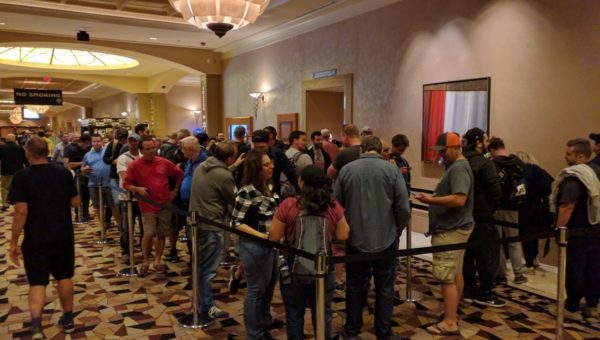
The hotel I was at was as close to the Rio as possible, as I planning on working the WSOP all summer. While I considered staying at one of the 5 best casinos in the city, I felt it more prudent to be walking distance from work rather than have to Uber each way every day. At the Subway, I’m surrounded by backpacks and hoodies, as well as stories of the bad beats players have encountered in the Big 50 tournament so far. At the moment, I’m trying to prevent flop sweat running down my back, and not make actual eye contact with anyone in line.
My normal job at the WSOP, as some of you know, is interviewing the players for the Poker PROductions bio team, usually once they reach the final table, except for the Main Event where we talk with them sooner. I gather their biographical information, which is then coupled with other research data and then given to the commentators for use during live streaming broadcasts.
I love the job. I love interviewing the players, getting to know them better, getting to meet people I would never be speaking with normally, all bound together by one singular passion. Even after numerous summers doing the job, I’m still curious why each and every one of them are there, whether seasoned by experience or there for their first time. The energy is palpable, for the players and for the people who work the event. I only see some of the members on my team once a year, for the Main Event, and every year it feels like yesterday and 100 years ago since I’ve seen them. It’s “Poker Summer Camp,” as so many people call it. We even buy shirts/hoodies that show that we’ve been to that same camp year after year.
The second day of the WSOP, I got horrifically sick. I did everything I could do to try and pull it together, to no avail. I’m so lucky to have the boss I do, who made it wonderfully easy for me to try and get better. But, in the midst of feeling like I could explode from the inside out, I had massive poker fomo. Reading the updates from PokerNews, on Twitter, from friends of mine on FB felt like “Oh f*&k, why aren’t I there?” I missed my friends, the energy, the excitement. However, reading the updates online still made me feel involved, a part of the poker community. The action that was happening less than a mile away from me was almost more painful than when I had poker fomo when I lived in Maui, Hawaii. There, it took a huge effort to want to go play at a card room, or speak to anyone who knew what a kill pot was.
However, as bad as that feeling was of missing out on the biggest season of poker, I’m so grateful for the poker online community. I got to vicariously be there, hear what was happening, be grateful that I didn’t see the man pull his pants down and throw a shoe at another player. I was so happy for my friends and team members who were still there, either playing it or working it. During the rest of the year, it makes me feel like we’re still connected, still asking about poker, wondering about Postle, about POY standings, about how we still need to change the perspective about what women want at a poker table (not shirtless dealers! I’ll touch on this in a future column).
READ MORE: 5 Reasons to Invite Women to Your Next Home Poker Game
I still remember one of my first times playing live poker. It was in the Orleans Ballroom upstairs (for some reason it was there that week), and people were speaking my language; language I’d learned in Rounders, from my mother, from playing with friends and family, and finally from playing at Stateline, NV for the first time live. This language is now stronger than ever, all over the world and in a format that keeps me updated constantly. Sometimes I go down the rabbit hole reading about it, but I’m just glad it’s there.
Turns out, I ended up inadvertently interviewing guys in the line at the Subway. As sick as I was, I couldn’t help myself. And I thought to myself, see you next year.
While slow rolling is not one of the newest poker terms, some players pretend not to know what it means or couldn’t care less about its implications. They seem to think that slow rolling is just hilarious.
They’ll take forever to turn over their cards only to show the nuts after giving you false hope you were winning. And, to add insult to injury, they’ll even start laughing about it as if you were somehow supposed to find it just as amusing.
Here’s a simple fact: slow rolling isn’t funny!

While it may be fine to do it among friends in a home game occasionally, this isn’t a practice condoned by a large majority of the poker community. Of course, there will always be that one guy in your game who doesn’t care about proper etiquette, and there isn’t much you can do about it. What you can do, though, is not be that person.
If you’re still not convinced and don’t see anything wrong with the practice, here’s the list of top three reasons why slow rolling isn’t funny and why you should avoid it.
A slow roll in poker only happens in live games, because it’s not really technically possible to do it online. As you probably know, live poker is pretty slow as it is. Depending on the dealer and how active the table is, you might see around 30 hands per hour at most (vs. far more than that online).
That’s assuming everyone acts quickly and in an orderly fashion.
A slow roller will often steal a couple minutes (or more) just to amuse themselves. Even if we disregard the fact it’s rude towards the player(s) involved in the hand, it’s also simply rude to everyone else at the table. They’re all there to play poker and they won’t get to see as many hands as they should per hour because of someone’s inability to follow the rules of proper poker table etiquette.
When it’s time for a showdown, just turn over your cards. There is no reason to keep your holdings hidden when you know you’re winning. Turn them over, rake in the pot, throw out a tip, and keep things moving.
Poker is an emotional game, and most people aren’t cold-blooded pros. Many players hit the tables just to have a good time or forget about other worldly concerns. Some of them are just gamblers looking to get lucky. At almost every poker table you join, you’ll find a colorful palette of characters.
Some of these people will take your attempt to be “funny” as a personal insult, especially if it’s accompanied by laughter and joking. You never know if that pot you just slow rolled someone out of was super-important to them.
Your actions could cause a lot of drama, and you might find yourself on a receiving end of some ugly insults, or worse. While you could argue that that kind of behavior has no place at a poker table, neither does slow rolling. If you consciously try to provoke someone into reacting, you better be prepared for some the consequences, come what may.
On top of that, your actions might push someone to leave the game, and nobody wants that to happen.
You can easily avoid it all by being a gracious winner. Turn over your hand quickly and take your chips without doing anything else to embarrass your opponent. They’ll likely respect you for it later even if they’re fuming at the moment.
If you’ve been playing poker for any significant amount of time, you’ve probably won at least a few pots at the last possible moment. I’m talking about situations where you’ve misread your hand and while getting ready to muck the cards, you realize that you have a flush or a straight.
Likewise, you’ve probably had this happen to you on occasion.
While this isn’t a “traditional” slow roll, the effect of it is somewhat similar. You basically conceded the pot only to turn over the winning hand at the last moment. Intentionally or not, your opponent likely won’t be thrilled.
To avoid this, always double-check your cards before you muck without announcing your action unless you are 100% certain. Take a couple of extra seconds to give the board one last glance and compare it to your whole cards if there is any doubt.
And if this does happen, apologize sincerely to your opponent (or accept a sincere apology from the other player if it happens to you). This type of slow roll is not too big of a deal since there was no intention. It’s a mistake that can happen to anyone and most players won’t hold it over your head.
Gambling has been a fun way to make some money on the side since the beginning of time… or a not so fun way to lose your entire fortune, house and family. It really depends on a player’s wits, skills, and level of self-control… and of course, luck. So yeah, gambling can be fun, but there are also plenty of risks involved.
Fortunately, we’ve come a long way as a species. Gone are the days when you could get buried in the Mojave Desert for upsetting the Las Vegas mob by winning in a poker game in which you should’ve lost. The entire industry is safer than ever, especially in countries like the US or UK, where regulations are strong and customer-oriented. What’s more, the rise of the Internet and mobile technologies made gambling even more secure: nowadays, provided you pick a licensed and SSL-secured platform, you may play casino games from the comfort of your home without any worries! Your poker mates can no longer kick you in the face after you take all their money.
With this in mind, we’ve decided to compile a list of 4 ways in which live casinos changed online poker gambling.
In recent years, due to the advent of live casino gambling, there has been a surge of new and better poker games. We’re including here Evolution Gaming titles such as Texas Hold’em, Live Three Card Poker, Live Ultimate Texas Hold’em and so on. Of course, we’re referring to games in which you compete against the house directly, rather than other players.
For a relatively low investment, you get the opportunity to play against a real dealer, in real-time, with real cards, for not too shabby jackpot prizes. Just like in a brick-and-mortar casino, but without the risk of getting robbed on your way home. What’s more, if you check the rules for any of the previously mentioned titles, you’ll see that there are countless new ways to play this classic casino game. Gameplay diversity is always a good thing!
The most challenging thing about real-life poker is that you usually need to keep your emotions in check if you want to win big. If you don’t wish to betray your intentions, you often have to act like a robot, and restrict your facial expressions and body language. That’s no fun, especially if you’re a cheery type of bloke! On the other hand, the annoying thing about software-based online poker is the fact that you can’t predict your opponents’ next moves by looking at their faces and mannerisms. So it’s a mixed bag. This is where live dealer poker games offer players a middle path: you can see the human dealer who runs the game via live streaming, but he or she cannot see you. So, in a sense, you get the best of both worlds.
Another positive side effect of live casino poker is that it creates more jobs than its virtual counterpart. If a website wishes to offer its customers this type of service, it has to invest more money in technology and staffing. A live casino studio usually employs several camera operators and dealers, a technology specialist to solve any technical glitches that may appear and a supervisor to make sure everything runs smoothly. Thus, the live casino industry helps boost the employment rate. So, whenever you choose to play live poker instead of virtual poker, keep in mind that to a limited extent you are helping to put food on people’s tables.
When the first live casino studios saw the light of day, during the 2000s, the Internet connections were much weaker and games kept freezing up during gambling sessions. But the demand for such games was already there and online casinos had to adapt, to make sure they keep up with the times and their customers’ tastes. That’s why the gambling industry was among the early proponents of better streaming technologies.
It might sound strange in today’s day and age, but streaming was really slow and low-res 15 years ago. Well, not anymore! Nowadays, online poker websites feature live titles where you can see the poker dealer in full HD and interact with him/her in real-time without your Internet connection dropping dead once every 2 minutes. In fact, some sites, like PokerStars, have even begun offering virtual reality poker!
So it seems that online poker has a bright future ahead.
Are poker players born or created to play the way they do? I am sure that genetics plays a significant role, but education and work experience could be even more important. Why are some much more aggressive than most of us? Why do many play so tight?

Screenshot from an episode of Westworld; used for illustrative purposes only
Recently, a guest contributor to Cardplayer Lifestyle, Sol Rosenbaum, published an article entitled Three Reasons Why Engineers Make Great Poker Players…. and One Reason Why They Don’t. Sol is a professional engineer specializing in energy technology, and as an engineer (M.S., MIT, 1952), I can comment on his ideas. I believe that there are both benefits and disadvantages to being an engineer that would manifest themselves at the poker table.
Generally speaking, the advantages that engineers have at the poker table are the same ones they have when playing online blackjack, namely their strength with numbers.
Engineers understand and are able to use the odds. Their extensive math education makes it relatively easy for engineers to estimate and make use of the odds – pot odds vs. card odds. Meanwhile, far fewer other poker players try to do so. They simply recognize that there are several cards that will help their hands and continue on. (Some unwittingly may be chasing with only a few outs. By the way, that may account for many of the bad beats we suffer. In the long run, chasers are destined to be losers.)
Engineers are skilled at recognizing situations and assessing the pertinent variables. Thus, they are better prepared to make those tough decisions they encounter so often at the poker table.
Engineers develop special skills in analyzing data, thereby reducing dependence on luck (chance). Consequently, their results at the poker table tend to be more positive and repeatable – and they can better avoid the losing hands.
While they might be great with numbers, engineers on the whole tend to be risk averse. As Rosenbaum explains, engineers are accustomed to using safety factors; often, they tend to overstate the risks. As a consequence, they are more likely to miss good opportunities to extract value from their opponents at the felt, as well as exercise a bit too much caution overall.
There is a bigger message here; namely, that your education and work experience will influence or determine how you play the game. Below are two examples:
A successful salesperson learns to make sales pitches, and to exaggerate the benefits of what he has to sell. Applying this to poker, then, he is more inclined to play aggressively and try more than his fair share of bluffs. As his opponent, knowing his work experience, you can use this information to your advantage. It’s a tell.
A businessman may play the game for two opposite reasons: for relaxation and pure recreation, or just as he would operate a successful business enterprise (i.e., to earn a significant profit). In the first instance, he makes it easier for his opponents to beat him. Most likely that’s the case if he is drinking and laughing or chatting with others around him. It’s just the opposite if he is serious and focused on the game; be cautious when he raises.
Of course, to capitalize on tendencies such as those described above, you would have to ask any player about his or her work. One way to find out is to casually ask him during a pause in the game, and note his response. Poker is meant to be a social game after all…
P.S. I regularly read the “Tournament Hand Matchups” in Card Player magazine and have often wondered why high-stakes players frequently play weak starting hands. Is there something in their education or work experience that leads them to such loose play? Email your comments to [email protected]. For the best answer submitted by a reader, received within two weeks of publishing, a copy of my book, The Art of Bluffing, is the prize.
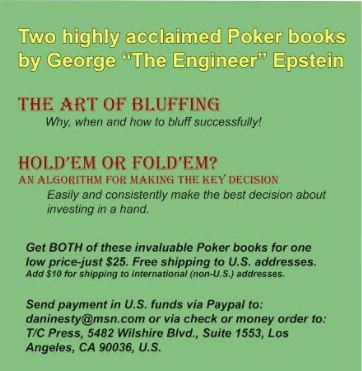
Over the years I’ve enjoyed reading stories from others about their experiences in the early days of the poker industry, working with some of the characters of the time. Dan Goldman, for example, recounts how he was hired to head up marketing at PokerStars (and tells many other great stories). Then we have Steve Badger’s ‘Stories from the Poker Boom’. For a poker geek like me who remembers a little of the good old days, these stories are gold.
I’ve now been in this industry long enough that I have some ‘old timer’ stories of my own, many of which from my time working with PokerStars and Full Tilt Poker between 2006 and 2011. I’m one of a handful of people to have worked for both Ray Bitar (Full Tilt Poker’s CEO) and Isai Scheinberg (Founder of PokerStars). In this article I thought it would be interesting to talk about my experiences with them, what similarities they had, and what made them different.
I’d been working for PokerStars for a year and a half before I met Isai for the first time. I’d just moved to the Isle of Man to take up a new role, and so was unfamiliar with much of the team there. It was an innocuous scenario – walking through the office with my line manager; we bumped into Isai and I was introduced as the new guy. He was polite and courteous, modestly dressed, and had a sense of humility about him. His accent was strong, and I later learned that he could speak at least four languages (English, Lithuanian, Russian and Hebrew). We said our hellos and moved on.


Isai Scheinberg | Image credit: Danny Maxwell
Meeting Ray Bitar for the first time was quite different. It was summer 2010, and I was in Las Vegas with friends for the WSOP. A meeting with Ray had been set up by the recruiter who had approached me about a role at Full Tilt. I waited downstairs in the Bellagio for about half an hour beyond the scheduled meeting time before Ray appeared and walked me to the elevator. I interviewed with him in his lavish suite overlooking the fountains, which was probably five times the size of the apartment I lived in at the time. We spoke about cars, who we thought would win the Main Event, and very little about work – clearly, the meeting was about establishing whether I was a ‘real poker guy’ or not, and whether we could work together on a personal level, not whether I was qualified for the role.
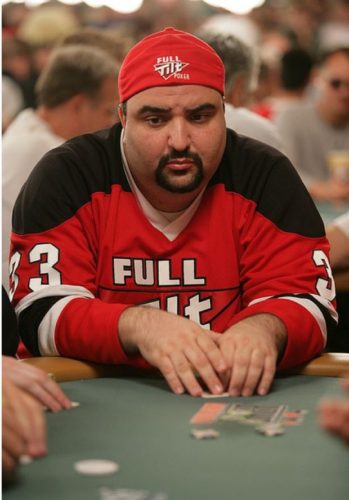

Ray Bitar | Image credit: Wickedchopspoker.com
You might think Ray was a show off, and I can understand why. In addition to the crazy big Bellagio suite, he drove a flashy car, had a massive corner office, and enjoyed his material wealth in many other ways. But actually, I don’t think he was trying to impress me or anyone else. (I was a 27-year-old guy. If he wanted to impress me, there would have been far more effective ways to do so.) I think he had grown insensitive to the value and importance of money. This trait sometimes showed itself in how generous he could be with his friends. Ultimately, I think this trait contributed to the downfall of Full Tilt.
Isai, on the other hand, was shrewd when it came to money. We would often fight hard to justify adding new staff to the team, and PokerStars’ software development team was famously lean. In hindsight it is remarkable what was achieved by so few people. When he did hire, he hired carefully – paying a good salary and recruiting passionate, knowledgeable and fiercely loyal people.
But Isai could also be fabulously generous, too. He strongly supported PokerStars’ many charitable initiatives, which often involved raising money within the poker client to be earmarked for donation. When he eventually departed the company after it was sold to Amaya, he and his son Mark gave bonuses to almost every employee, amounting to 1 month’s salary for every year of service – a phenomenal sum of money for many people (and quite the boost to Isle of Man car sales!). These days, he is actively involved in charitable initiatives on the Isle of Man and is known for being generous with the one thing a billionaire doesn’t have much of – his time.
As is often the case with founder-leaders, Isai was notoriously hands-on. He knew every detail of the business and was involved in even the tiniest aspects of promotions, the tournament offerings, the product, game integrity cases, you name it. Get something wrong and he could be scathing and brutal. His desire to give approval on everyday tasks often slowed things to a crawl. I learned a lot from Isai but as I have developed as a leader myself, I have tried hard not to emulate this characteristic, as it made working for him extremely frustrating at times. The company Isai built was utterly dependent on him, and it has suffered since his departure.
Ray, on the other hand, was a hands-off type. I reported directly to him, but he delegated almost all responsibility in managing me to others. If he was involved in the detail, it was because the subject matter was deeply important. For example, the first time I saw him get really involved was because the issue in question was eChecks not clearing, but still being credited to players’ accounts – the infamous ‘phantom deposits’ issue. “It’s literally costing us millions of dollars”, I remember him saying. The downside to being hands-off, of course, is that when it hits the fan you might not have the knowledge or awareness you need to act quickly and decisively.
Despite their differences, Isai and Ray had more in common than you might think. Both were hardworking and straight talking, and they built companies that were hardworking and straight talking, too, albeit in different ways. PokerStars felt like a family business, while Full Tilt felt like a Silicon Valley tech startup. At both companies, people disagreed openly and passionately. You had to be resilient, but it was incredibly productive. At both PokerStars and Full Tilt, employees bonded over their shared love of poker. They were tight communities where we worked and played together, on the felt and off. (Incidentally, both company home games were a lot of fun, but the Full Tilt game was a LOT tougher.)
So there we have it. Two leaders who were hardworking, and who built and scaled successful companies with brilliant cultures, but with different styles. Isai with his financial shrewdness and hands-on approach. Ray, the delegator with no sense of the value of money.
When Black Friday hit on April 15th, 2011, the two leaders’ styles would contribute to the difference in outcomes for each company. Isai saw it coming, was prepared, and had all of the knowledge of day-to-day operations he needed to jump into action.
Ray was caught off guard. For the most part he had delegated the finances of the business to the CFO. He had a huge mountain to climb in understanding the true financial situation of the business, which turned out to be worse than anyone thought.
We all know what happened next and the implications it had for players and the entire online poker industry. I understand that many people take comfort in having a figurehead to blame for the demise of Full Tilt, but Ray’s actions weren’t those of an evil person. They were those of a person who was woefully unprepared for the challenge he faced.
If two other people had been in charge, who knows? Things might have ended up differently.
With a name like Pokercode, your first visit to the website and entering your username and password feels like opening a vault. A vault that has tremendous value in it provided by none other than German ´prince of the high rollers´ Fedor Holz and high stakes crusher Matthias Eibinger. Holz and Eibinger did their very best to produce top-notch content, which formed the core of the Pokercode.
Expanding beyond the core offering, Simon Rønnow has also been brought in to add his knowledge on specific topics like squeezing and facing 3-bets. The initial course is shot in an amazing studio with Holz walking you through every little piece of information they give you. It feels as if Holz is your personal coach, letting you in on all the little secrets that made him millions and millions of dollars over his poker career. But Pokercode is far more than just a course. It is an all encompassing community of like-minded poker players looking to improve and become the best player they can.
Personally, I felt a bit scared starting it all up as I had never done any poker study before trying Pokercode. This was going to be my first proper go at becoming a better poker player. The lectures started out very welcoming, with Fedor referencing a book outside of poker that helped him get in the proper mindset. That one word — MINDSET — is something he talks about a lot in the first couple of videos and that sets the tone for what you will eventually learn during the course. Right from the get-go I immediately began to feel some sort of change happening in my head that motivated me to tackle the beast that is the Pokercode and become a better player.
Holz is very clear that this course is based on GTO play, but he will also teach you how to adjust your strategy so you can exploit your opponents and their weaknesses. He does have separate videos at the end of most sections of the course that illustrate how Fedor himself adjusts and deviates from GTO strategy to exploit his opponents even more.
The Pokercode consists of five parts, and the first part begins with a general introduction called “Getting Started: Pre-flop.” After the introduction we begin diving headfirst in the first bits of poker strategy, and — WOW — we zoom from 0 to 100 really quickly! I have to admit that I was pretty overwhelmed by the rapid-fire of information that was given over in the first couple of sections.
Before going any further, let’s break down the Pokercode by the numbers:
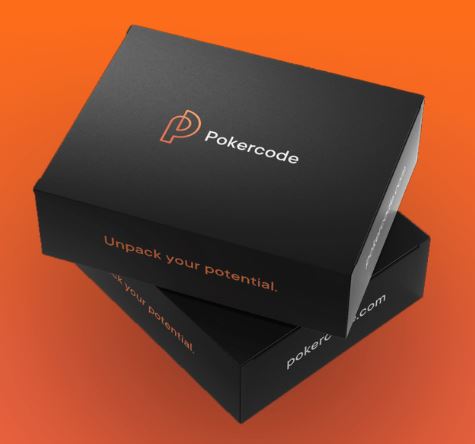

The first part of the course consists of 24 videos varying from a couple of minutes to about 15 minutes in length. The videos are split up into five sections:
All sections contain multiple videos and after each video there’s a quiz. The questions are either multiple choice or true/false and you will get 1, 3, or 5 points depending on how many tries it takes you to give the correct answer.
If you don’t get the answer after three tries, you have the option to skip the question, but you are actively encouraged to re-watch the video. It’s really critical to understand the first part of the course before moving on to the next part. I must admit that I had to re-watch some of the videos because there was just too much information for me to absorb. This might not be the case for most students, but since I had never studied poker properly before it was a bit overwhelming.
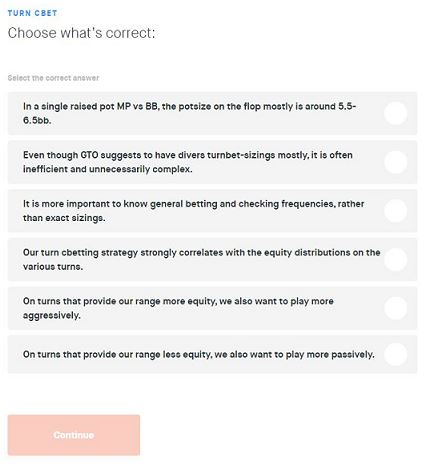

Pokercode Quiz; sample questions
The first couple of quizzes I did were manageable, but the deeper I dove into the course the tougher the questions ended up being. At first, I didn’t even realize I was able to skip the questions so I just re-watched the videos, which I feel is a good thing. Fedor explains at the beginning of the course that your pre-flop mistakes can do more damage when you continue post-flop. Like most players, ideally I want to get better at poker quickly. That’s why I felt it was great for Pokercode to encourage that you get the pre-flop fundamentals straight before hopping over to the post-flop section. Just like in poker, you can’t force the action!
I internalized an important thing from this course, namely that there is no shortcut to getting better: you must learn one video and one concept at a time. The quizzes helped to give me a great idea as to whether I had correctly understood the concepts being taught. It’s one thing to understand the rationale given for decision-making in one specific situation. It’s another thing entirely to be able to understand the underlying decision-making rationale and be able to apply it to all situations that come up at the poker table.
I feel it’s important to note that the Pokercode is not designed for complete beginners. You need to have a good understanding of the game’s basic strategy or you’re going to have a tough time understanding what Fedor is talking about. Also, you need to be more than “just a little bit motivated” to learn and improve your game because these videos are not made for casual, passive viewing. Focus is required and the subject matter being taught is very tough, but there is tremendous value in making the effort to study properly. That said, it would’ve been good to see some sort of disclaimer at the start that this course can get complicated.
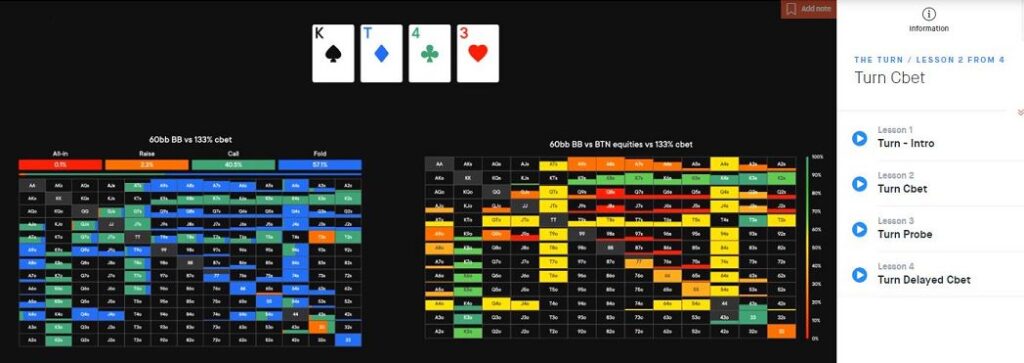

After about one hour of study, I started to feel a bit of information overload, so I quit for the day and started again with a fresh head the following day. There’s a lesson in there for you if you’re thinking of subscribing to Pokercode: don’t think that you can just zip through all the poker training content in one day. Your head will explode! You’ve got to give yourself enough time to process and internalize each of the lessons before moving on to the next steps and videos.
Once you reach the “How to Defend the Blinds” portion of the course, you’ll for the first time be exposed to… Charts! Glorious charts! Fedor will explain to you how the charts work and in which situations they’re relevant. While charts might be a familiar sight to many poker players, they still scared me a little bit as I had never taken such a deep dive into poker strategy before. The charts not only tell you what actions to take and when, but also how frequently you should take a certain action. I understood these general concepts pretty quickly, but figuring out specifically how the charts were supposed to work kind of rattled me in a way that I didn’t expect when I started the course.


For me, this was my first time actively learning about frequencies, and I finally came to understand what “balancing” meant. (Spoiler: It’s not standing on one foot and trying not to fall over.) I had to watch and re-watch the videos multiple times to understand what Fedor was telling me, and — once again — the quizzes helped me gauge whether I properly understood the concepts being taught.
At the end of some lecture sessions, Holz will share with you his personal adaptations to the GTO strategy. He will explain how he adjusts his playing style to exploit his opponents, which gives you the tools to do so yourself. This is where I feel there’s a lot of the value in Pokercode. You can learn GTO poker from many different coaching websites, but Fedor Holz sharing his personal tips, tricks, and exploits is something else and felt incredible to watch. Watching those videos on the train where he explains how he personally adapts gave me the feeling that I needed to cover up the screen on my laptop. It felt as if I was watching porn on the train and no one else should be allowed to see what was on my screen.


Pokercode dashboard
I noticed some changes in the way I approach playing poker after I was done with the first part of Pokercode. Fedor gives you the right tools to start thinking in terms of ranges rather than just specific hands. I was aware that the top pros do this, but I had no clue how to exactly approach it and start doing so myself. Since I’ve begun using the Pokercode I do think I have a better understanding of this concept. I’ve also started to feel more and more sure of what to do in certain spots, which has been a personal breakthrough. I used to sort of guess with my decision-making and never used to analyze any spots after the fact. Now I’ve started asking myself the right questions that help me arrive at what I believe is the best decision, with increasing speed.
The second part of the course consists of six sections with a total of 22 videos. This is where I started to struggle a little bit, but I am already looking forward to re-watching most of these videos to get a better understanding. There’s just so much valuable information to master!
This is also the point where the videos begin getting longer; few of them are shorter than 10 minutes at this point. Within the Pokercode, the videos are labeled as easy, medium, and hard. All of these post-flop sections are labeled hard, and I understand why. There are lots of charts and Fedor presents multiple situations where we can choose to deviate from GTO strategy.
Fedor tackles short-stacked examples, deep stacked examples, looser opponents, tighter opponents, and more. Ranges are examined thoroughly, as well as where and how we can decide to deviate from optimal play. I managed to get through the first video, but the next ones made my head spin. Video is the optimal medium, and the Pokercode lessons are extremely well-produced, but it really takes maximum concentration to try and keep up with Fedor as he goes through the charts and different situations. (I guess if this were easy, everyone would be beasting tournaments and winning millions, right?)
As far as my personal study process, like I mentioned already, I had to pause videos multiple times and re-watch. Even so, I found myself failing the quizzes. While it’s a frustrating process, this did motivate me to keep learning and improving; and this has been happening slowly but surely. That’s what “getting in the lab” to study is all about!
Once again, it’s important to clarify that Pokercode is not a course for beginners or amateurs who just enjoy playing recreationally!
As I progressed through the course’s additional Post-flop sections including: The Turn, The River, 3-Bet Pots, Blind Versus Blind, and Multi-way I noticed that while on the one hand the videos were getting tougher and tougher, their value kept rising At a certain point, I doubled back to review some of the pre-flop sections, so I could get a better understanding of ranges again. This certainly helped in terms of my processing the post-flop lessons. I even started getting more answers right on the quizzes.
One thing I’d recommend: don’t implement a certain strategy in your game yet if you don’t fully understand the concept of why you should implement it in your game.
When I try to teach my girlfriend how to play poker, she sometimes says that I explain it in a way that is already too complicated for her. Trying the Pokercode finally made me truly understand what that means. I had a tough time keeping up! That’s not to say that Fedor doesn’t explain things well, but rather that the material itself is just very dense and complex. Even so, I think I have tons to gain by taking the course.
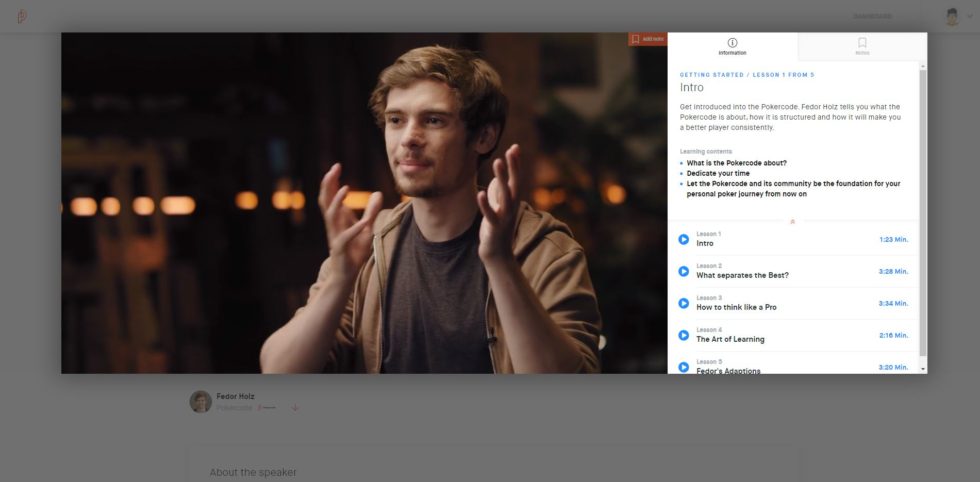

Fedor Holz presenting Pokercode
READ MORE: An Interview with Fedor Holz
I admit that it likely takes me longer to understand all the concepts than it does a medium or high stakes crusher. Even so, in poker it doesn’t matter how long it takes you to reach the finish line, so long as you eventually get there. Pokercode will get you there! You just need to pay close attention to every lesson as you keep building your personal knowledge base.
Perhaps “finish line” isn’t the right term though, as I’m unsure if you can actually finish this course. I feel like the Pokercode is a course that keeps on giving and continues to maintain its value, even if you have already watched the videos and lectures multiple times. You can really get in Fedor´s head throughout this course and it truly feels as if he is your personal coach.
This is the third part of the course where things got fun for me once again. Winning at poker isn’t just about GTO strategy; it’s about mindset, your behavior at the table, tells, and other important information like how to deal with ICM. This last part of Pokercode consists of four lessons and a combined 19 videos.
First, you’ll learn about ICM, which is a critical subject for tournament players to understand. After explaining the idea, Fedor guides you through how ICM can be applied to your game, and then how to adjust your game after taking into account ICM considerations. Even if you think you have a good understanding of ICM, I’m pretty certain that after watching the six videos in this part of the course you’ll have learned a lot. In other words, whether you’re a starting pro or already an advanced player, there’s value to be had here.
The next lesson, entitled “live game” was my absolute favorite. The videos here take you through all the different aspects of live poker that you don’t have playing online. One of these is obviously trying to profile players and to see if you can spot any tells. After demonstrating how to spot tells, Fedor also teaches you how to mask your own tells and elaborates on the importance of table image. It was quite fun to watch, and really made me eager to hit the tables! I felt sad when this part of the course ended and there were no additional videos of this category to watch.
In the very first Pokercode video, Fedor explains that poker is not only about how you play but also about how you approach the game in general. To point, in the four “Off the Felt” videos of this part of the course, Fedor provides you with some tools to improve on mindset, game selection, and bankroll management. While I imagine that most people that this course is targeted at would already have that bit sorted out, it’s still an important part of the Pokercode.
Apart from having video lectures and live coaching sessions, the Pokercode also features a handy preflop range tool called the Rangeviewer and an amazing community. The Rangeviewer allows you to look up preflop ranges for a variety of stack sizes and situations one might encounter playing tournaments. The tool is developed in-house and Matthias Eibinger and Simon Rønnow spent countless hours perfecting the ranges.
Subscribing to Pokercode also comes with access to the exclusive Pokercode community. With all Pokercode subscribers encouraged to participate in hand history discussions, database reviews, and countless like-minded poker players, including Fedor Holz, Matthias Eibinger, Simon Rønnow, and community coach Curtis.
Finally, Pokercode ends with three videos focused on practical play. After a brief introduction, we go through a couple live poker hands together with Fedor. The video pauses at the appropriate points so that you, the student, can try and work things out for yourself. Only after giving you a moment to think things through does play resume to see how Fedor would tackle the situations. With time, Fedor will keep adding additional hands to this section, and I feel that that offers even more incredible value that makes subscribing to Pokercode a truly worthwhile investment.
While it’s undeniable that Pokercode will boost your poker game and enable you to add tremendously to your overall skillset at the felt, as with most things in life there’s a price to pay. Astute students of poker, however, realize that when it comes to poker training, it’s not a cost, but rather an investment, which is likely to generate anywhere from decent to excellent ROI.
Pokercode recently revamped it’s pricing model to allow for three options:
While you get the best value by exercising the Yearly option, the other pricing points give you the ability to try out all facets of Pokercode without having to make the full financial commitment if you’re not ready to take the plunge and prefer to just dip your toes in the water. Moreover, you even get a 14-day money-back guarantee!
While I’m sure there’s plenty for cash game specialists to take away, the course is focused on tournament players, as illustrated by Fedor talking about situations that are 20, 40, 60, or 100 big blinds deep. The videos are impeccably well-produced and easily navigable. The quizzes at the end give you a good grasp of how well you understand a certain concept and you can always re-watch a video as many times as you’d like to improve further. This poker training course isn’t for everyone, but if you are interested in learning how to play tournament poker at the very best level, you should definitely give Pokercode a try.
Most poker players are fair and honest, but there are always those looking to take advantage of less experienced opponents. Poker is supposed to be a gentlemen’s game, but that is unfortunately not always the case.
If you’re new to the game, you may want to be aware of some of the tricks that can be used against you. I’m not talking about sharks who are after your money. Instead, I’m talking about those so called “foxes”… the players using various angle shooting techniques to try and win your chips by gaining an unfair advantage.


Those who angle-shoot aren’t clever, by any means…
The thing is, angle shooting isn’t against the rules, strictly speaking, so it’s up to you to keep your wits about you and be very careful not to fall victim to such actions.
In this article, I’ll explain three of the most common angle shooting techniques you’ll likely encounter at one point or another, especially in live games.
String betting is usually not allowed by the casinos, and the player trying to pull this angle usually won’t get away with it. However, you can’t always count on the dealer or other players protecting you against it. After all, it’s your money on the line, so you should be the one paying the most attention.
The way this angle usually works is that a player will try to scare you into reacting by adding chips to their bet. Say you bet $100 on the turn, and they announce a raise. Then they slide $100 in the middle, followed by another $100. Then, they glance over to see your reaction and slide another $200.
First of all, in most casinos, only the first $100 will count towards the raise, so you don’t have to worry about it. They know it, too, but they are trying to see if you’ll react to them piling on more chips to their bet.
Newer players who aren’t aware of the rules and don’t have as much experience might fall victim to this string betting angle shoot. They won’t know that only the first $100 plays and they might send their cards into the muck, thinking the opponent made a huge raise. Of course, once the cards are mixed into the muck and can’t be identified anymore, the hand is dead.
The best way to protect against a string bet is to never fold your cards or make any move until the dealer announces the action. That way, you’ll be safe.
I have seen quite a few players trying to misrepresent their hand when it’s the time for a showdown. They’ll yell “flush” or “full house” only to proceed and table an Ace-high or a single pair. Not all of them are doing it to angle shoot, or with bad intentions, and may just think of it as a funny joke.
One way or the other, as mentioned above, poker rules are quite clear with regards to mucking your cards. If someone verbally misrepresents their hand and you instantly muck your cards without waiting for the actual showdown, and they can no longer be clearly identified, you will lose the pot. Once your cards hit the muck and can no longer be reliably retrieved, your hand is dead, and you can’t reclaim it. This sometimes happens if you’re tilting (yet another reason to try and avoid tilt).
Now, in friendly cash games or home games, if a player was joking, they’ll sometimes let you retrieve your cards and win the pot. However, if they were looking for angles to shoot, you’re out of luck. They might get a warning from the floor and a penalty if it’s a tournament, but in a cash game, you need to be careful about these things.
If your opponent announces a full house at showdown, nod your head and wait for them to table their hand. If they have it, they win the pot. There is no need for you to rush and muck your cards before the actual showdown, though, and no player will fault you for waiting for the cards to be shown before you concede.
If you’ve been playing live poker for a while, you’ve probably come across those players whose hands never rest. They constantly tap the table, run their fingers across the felt, and make other motions that could easily be interpreted as a check when it’s their turn to act.
Not all of these people do it to angle shoot you, but if you make a mistake and announce your intention thinking they checked, you’ll give them new information they can use against you. So, they could angle shoot you by accident, but you’ll still be in a bit of a pickle.
It’s impossible to control every action at the table, and poker would be a very boring game if people had to sit like statues all the time. So, you’ll have to deal with these players, and they won’t stop doing whatever they’re doing.
To protect yourself, always wait for the dealer to announce the action and double-check if the action has been passed to you if you are not sure. This only takes a few seconds and can save you a ton of money in the long run.
Professional poker is a serious business. Getting to an almost Zen-like state of mind that allows you to know when to hold’em and when to fold’em takes concentration, discipline and stoicism. However, even in the heat of battle, when bets, bluffs and chips are raining down, there’s always room for a joke or two. In fact, over the years, poker has produced some comic moments that will forever raise a smile among those who take a seat at the felt.
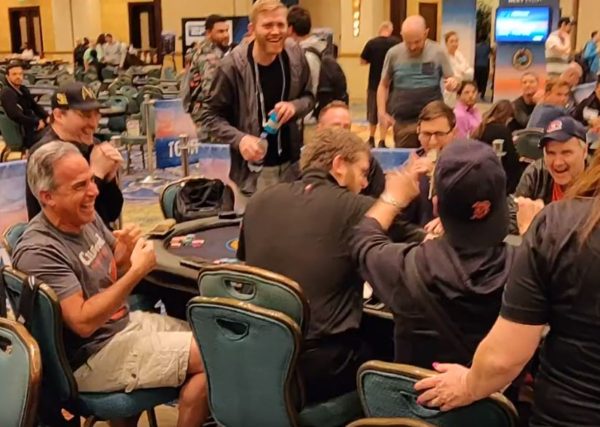

Cliff Josephy, Phil Hellmuth, Norm Macdonald, and others have a laugh at the poker table
Of course, there has always been a subculture of comedy in poker. Texas road gamblers were known to spin a yarn or two and the poker table was the perfect place to hold court. Whether it was a tall tale, a hand that went awry or a quick joke, players have also found time for fun. In fact, comedy can actually be a useful way to disarm your opponents and put them at ease before you launch an attack. If you go to this site covering some of the (cheesiest) poker jokes, you’ll pick up a quip or two.
Of course, you might need more than a one-liner such as “why is gambling banned in Africa? Too many cheetahs”, to distract your opponents and steal a pot. However, jokes can be a great way to create a jovial image. From there, you can start to tell some stories of your own or you can recount some of poker’s funniest stories. To help you spin a yarn, tie your opponent in knots and have them in stitches, we’ve outlined some of the game’s greatest capers. So, without further ado, sit back, relax and let’s have some fun…
There’s always something happening at the WSOP. Usually, it’s amateurs making their fortune and pros adding to their already burgeoning bankrolls. However, there are also times when something unexpected happens, and 2010 was one of those times. With companies seeing the WSOP as a commercial opportunity, an online poker operator tried to enter a chimp into the Main Event.
Clearly inspired by this, Jack Link’s let sasquatch run amok inside the Rio Casino during the 2010 festival. As a headline sponsor, the American beef jerky company had cleared the deal with WSOP officials beforehand. However, it certainly startled players when a 10-foot tall beast went on a rampage across the poker room.
He may not have found it funny at the time, but the poker community was buzzing after Daniel Negreanu bought into the same event 48 times! Never one to shy away from saying what he thinks, Negreanu has produced a number of popular vlogs about his time at the WSOP. However, in 2009 it seems he was more intent on letting his money do the talking.
Hellbent on winning a bracelet, he re-entered a $1,000 tournament 47 times. That, on top of his original buy-in, meant he spent $48,000 trying to win gold. To break even, he needed to finish in the top 10. Not only did he fail in that mission, he failed to make the money at all! To top things off, his old rival Phil Hellmuth went on to win the event.
We love Phil Hellmuth. Despite his tantrums, tears and foul-mouthed tirades, he’s been one of poker’s best ambassadors for years. Naturally, we couldn’t do a rundown of funny moments without mentioning the Poker Brat (multiple times). However, in this review, we’re not going to highlight one of his many, many rants. Instead, we’re going to look at the time he crashed.
Set up as a PR stunt, the incident saw Hellmuth speed across the Rio’s parking lot in a racecar and smash into a concrete post. At the time, there were rumors it was a fake crash. Regardless, the incident made the news and certainly gave everyone a chance to laugh once they discovered Hellmuth wasn’t seriously injured.
He might be the best player in the world, but even Phil Ivey is prone to mistakes. Whether he thinks it’s funny or not is another matter. However, to see the great man let go of a winner does raise an eyebrow or two. The story goes that Ivey didn’t realize there were spades in his hand in that critical WSOP Main Event hand. Unfortunately, the 5s Qh 10s Qs As board did, in fact, give him a flush.
When he was told that his blunder was captured on camera, Ivey wasn’t a happy camper. The viewers, on the other hand, got to chuckle safe in the knowledge that even the greats can make a mistake from time to time.
It’s an oldie, but it’s a goodie. Anyone who knows poker players knows that they love a prop bet. In 1996, Brain Zembic made the ultimate bet and agreed to get breast implants. The stipulation was that he had to keep them for a year to win $100,000. Well, he not only followed through on his side of the bet and cashed $100,000, but he also kept his newfound assets for a lot longer than a year.
If you can’t get a laugh from that story, you may need to work on your delivery. If you can, you may just be able to win over your tablemates, make a few friends at least and pinch a few pots at best.
When I first started playing poker, I had no clue what I was doing.
“You played that hand terribly,” the man sitting next to me told me once. “Really?” I asked. “How so?”
“Well for starters,” he said. “I could see your cards.”
This kind of behavior wasn’t unusual to me – as a young girl at a casino, I was used to getting advice (he wasn’t wrong by the way – I flat-called pre-flop with A♣K♣, flopped the nut flush draw, checked it down the whole way and lost). As a matter of fact, commentary was welcome: I desperately wanted to learn the game but didn’t know how.


Me, at the poker table
I wasn’t totally a rookie – my dad plays Hold ‘Em, and he’d taught me a thing or two. But it’s very different playing poker for play money with your dad and Grandpa in front of the T.V. on New Years than playing in a casino. I knew that a flush beats a straight but not which two pair beats which two pair. Or that two pair can get “counterfeited.” Or that pre-flop, you’re supposed to raise. Whoops.
Most importantly, I hadn’t learned the #1 lesson in poker: You don’t know as much as you think you know. And at age 23, I hadn’t learned that in life either.
While it may sound silly to describe learning poker as coming of age story, let’s just say “Coloring Up” would be my kind of chick flick.
And I did love colors – rainbow, girly, bright colors. Red, orange, yellow… magenta. I liked colors so much that I made more than 180 pastel flashcards with neon sticker labels – a surefire way to learn poker starting hands. I found a pre-flop raise chart online and some free Texas Hold ‘Em quizzes which I converted to my very own rainbow study set. My first few flashcards had to be redone because nothing smears like gel pen.
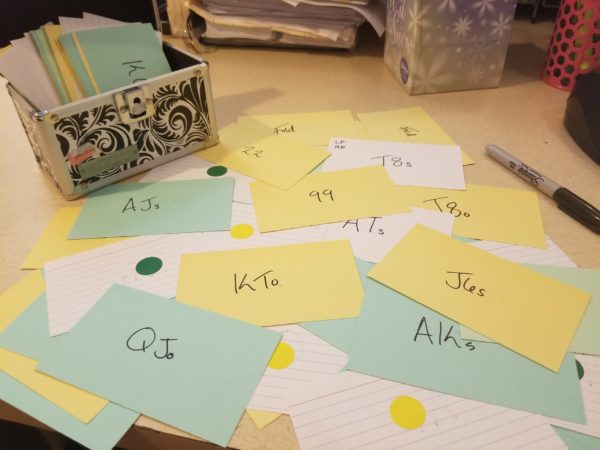

My original poker flashcards
I wanted to learn poker, and I wanted to stay true to my female identity.
Casinos aren’t very good for either.
I found quickly that you’ll learn more from a few nights (or lunch breaks!) studying than you will in a few months playing. And when it comes to getting in touch with one’s feminine side, it’s best not to smile when you 3-bet. Or giggle. (Unless you are a master of human interaction – in which case, go for it! But I’m the kind of gal who buys books on how to handshake non-awkwardly.)
As I wrestled with the highs and lows of my early 20s – moving from California to D.C., landing my political dream job, getting laid off after an election, gaining weight, losing weight, and supposedly finding my future husband every two months before realizing that’s not him – I experienced the swings of poker. The rush of winning my first tournament, the cruelty of consecutive coolers. I did exciting things like grind $2 online into $500, and depressing things like move back to California where I was reminded of all my social problems in high school. Life has its own kind of up and down variance – talk about needing a big bankroll(!).
Played my first live poker tournament today… And won first place. 🙂 pic.twitter.com/4G8ib4K1GH
— Amanda Botfeld (@amandabotfeld) May 22, 2017
Never would I have predicted spending my 25th birthday in a 4:00 AM heads-up battle with a rude, curmudgeonly old man at the end of a Bicycle Casino midnight tourney. (We got it all-in pre-flop 99 vs AT and I lost the flip. I took second place prize money and left the casino wondering what on Earth I’m doing with my life. Typical 25!)
And while I hadn’t yet figured out who I was in the world, I had figured out which hands to fold pre-flop.
Just finished my 2nd online poker tournament. Fifth place out of 139 entrants. 🙂
— Amanda Botfeld (@amandabotfeld) May 21, 2017
Poker became a hobby, an obsession, and a coping mechanism. As a former research associate specializing in Israel/the Palestinian Authority, I liked things that were complicated. Just like in my previous career path, I found great peace and focus putting together various moving parts, trying to solve a seemingly unsolvable game. Whether it be poker, politics, or the pursuit of happiness.
I hadn’t figured out the last two (still no peace in the Middle East). But when it came to poker, I had cracked the code: I knew what it took to win. And I wanted to write a book about it (I’ve never been very good at keeping secrets… !) With that goal in mind, A Girl’s Guide to Poker was born.
My book A GIRL’S GUIDE TO POKER is available now as ebook! Paperback in Jan. Subscribe for updates on my site https://t.co/1vCUNs5aRU , and pick it up here: #poker #newbook #pokerplayer #womenwriters https://t.co/WKfsKA416u pic.twitter.com/Ae0jgo0Upg
— Amanda Botfeld (@amandabotfeld) December 10, 2019
I’d already done quite a bit of writing in my past but none of it felt fully “me.” It was either intellectual and serious (like my piece on Facebook’s responsibility in combating Middle Eastern terrorism in the Wall Street Journal), or frilly and zippy (like my article on dating in the Los Angeles Times). They were parts of me, but even after having several pieces published, none told the true story. Nothing was both girly and smart – until it came to my book on poker. Texas Hold’em was the ultimate test of personality and cleverness. The felt was where booksmarts and streetsmarts could combine, where it pays to know your numbers and your smirks. Literally.
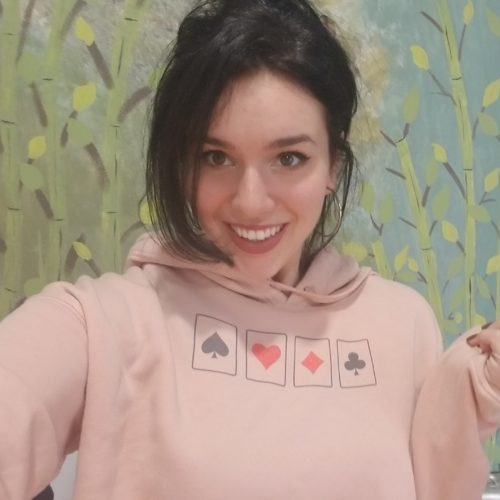

Funny enough, I never intended to write the book A Girl’s Guide to Poker for a female audience. The how-to and strategy advice applies to men and women. Cards don’t notice if you wear slacks or skirts. I didn’t start it as a women’s poker book, I started it as a woman’s.
I wanted to write it in my own voice.
Which makes it more about girl power than anything I could have purposefully conceived.
This “Greatest WSOP Player of the Year” list is a look at some of the most dominant World Series of Poker runs in the 16-year history of the WSOP Player of the Year (POY) award. Many in the poker community were quite simply glued to monitoring the leaderboard throughout the WSOP and WSOP Europe this year.
The 2019 WSOP offered poker aficionados one of the closest and most compelling POY races ever, with fans around the world, in the UK in particular, placing bets on sites like BettingLounge on their favorite players. Robert Campbell narrowly edging out past POYs Shaun Deeb (2018) and Daniel Negreanu (2004, 2014) when all was said and done. It took all 97 eligible bracelet events and a much buzzed-about correction in point calculations in the WSOP aftermath to decide the eventual winner.
Races of any nature are always competitive, and Campbell’s victory was one of the most compelling we’ve seen since the POY distinction was introduced in 2004. With that in mind, below we rank the five most impressive runs to the Player of the Year award, from 2004 to present.
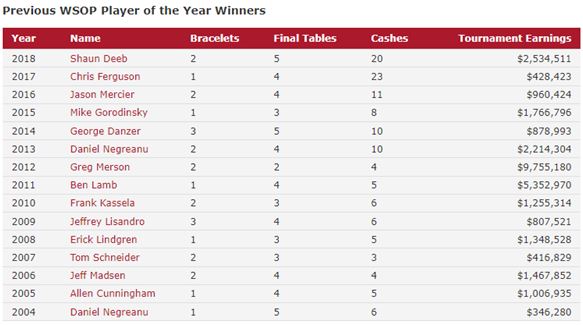

Jeff Lisandro is one of two players on the POY list to have won three bracelets in a single WSOP, and that accomplishment alone makes the Australian stud specialist a must-include on this list.
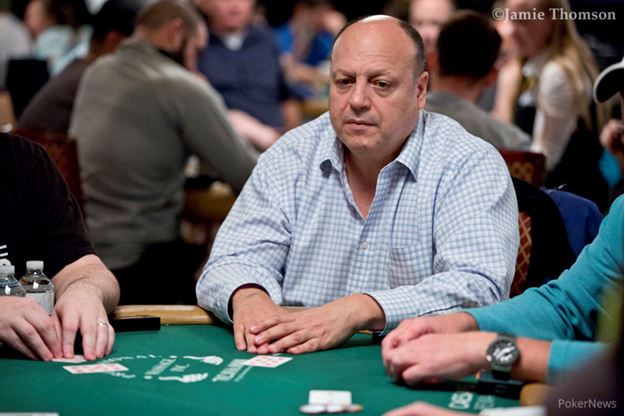

Lisandro won all three of his 2009 bracelets in stud variants, with the wins coming in $10,000 World Championship Seven Card Stud Hi-Lo ($431,656), $2,500 Seven Card Razz ($188,390) and $1,500 Seven Card Stud ($124,975).
The legendary stud player also made a fourth final table appearance, finishing ninth in the $10,000 World Championship Seven Card Stud event.
With six career WSOP bracelets, Lisandro is one of the most accomplished players in WSOP history, and his 2009 run is one for the record books.
Much like Lisandro, George Danzer makes this list as one of two WSOP POY award winners to take home three bracelets in a single year.
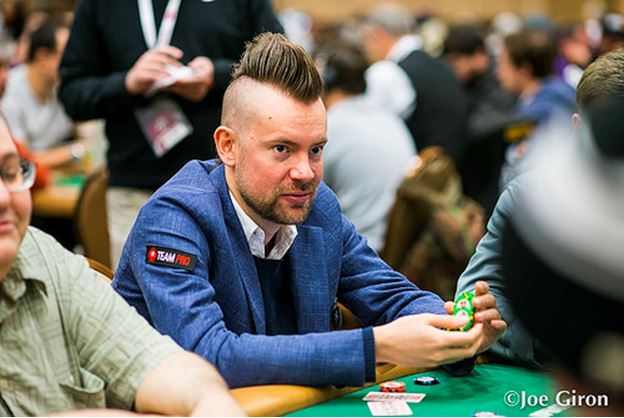

Like Deeb, Danzer has proven to be a master of several different poker variants. Danzer’s trio of 2014 bracelets came in $10,000 Seven Card Razz ($294,792), $10,000 Seven Card Stud Hi-Lo ($352,696), and the A$5,000 Eight-Game Mixed event ($74,760) at the 2014 WSOP Asia-Pacific, held at the Crown Casino in Melbourne, Australia.
Danzer’s 10 total cashes also included final table appearances in the $10,000 Limit 2-7 Triple Draw event ($70,308) and A$ 1,650 Eight-Game Dealer’s Choice ($6,499).
The German poker crusher also cashed in Omaha/Seven Card Stud Hi-Lo mixed, No Limit Hold’em, and Pot Limit Omaha events at the 2014 WSOP.
Ben Lamb boasts the second-highest money for a Player of the Year in the series in which they won the award. The then 26-year-old Lamb put together one of the best WSOP runs we’ve ever seen in 2011, coming away with $5,352,970 in total prize money.
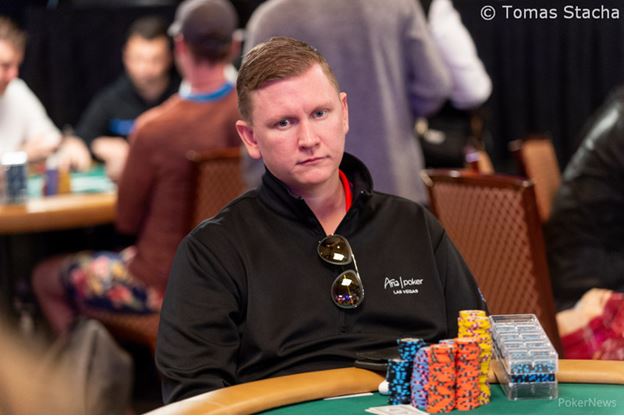

Lamb cashed in five events that year, a low number in comparison to Deeb’s 20 cashes in 2018, or 2017 POY winner Chris Ferguson’s 23 cashes. All five cashes, however, brought in big money for ‘Benba’.
Four of Lamb’s five cashes came in tournaments with a $10,000 or higher buy-in, including his third-place finish in the 2011 Main Event for a career-best $4,021,138 payday.
The Main Event showing was one of four six-figure plus cashes for Lamb in 2011. Lamb took home his first and only career WSOP bracelet with a win in the $10,000 Pot Limit Omaha Championship ($814,436).
He also posted a runner-up finish in the $3,000 Pot Limit Omaha event ($259,918), an eighth-place finish in the $50,000 Poker Players Championship ($201,338), and a twelfth-place showing in the $10,000 No Limit Hold’em Six Handed Championship.
Shaun Deeb, 2018
Shaun Deeb’s run at the 2018 WSOP is one of the greatest ever, with Deeb winning the POY award by a wide margin in the point standings.
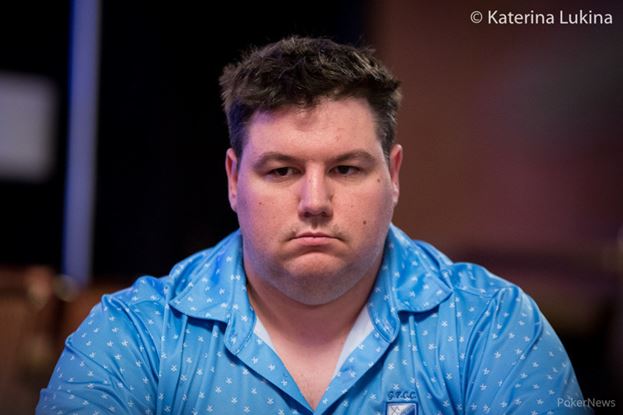

Deeb’s landslide win in the POY chase came as the result of 20 cashes, five final tables and two bracelet wins. The first-place finishes, which brought Deeb’s number of career of WSOP bracelets up to four, came in the $25,000 Pot-Limit Omaha High Roller ($1,402,683) and $10,000 No Limit Six-Handed Big Blind Ante ($814,179).
Deeb narrowly missed out on a third bracelet at the 2018 WSOP Europe, finishing second in the €1,500 Pot Limit Omaha/ No Limit Hold’em Mixed event ($73,410). His other final table appearance came in a fourth-place showing in the $1,500 No Limit 2-7 Lowball Draw event ($36,330).
Perhaps the biggest testament to Deeb’s overall ability is his results across all of the different variants of poker. His 20 cashes at the 2018 WSOP included money finishes in No-Limit Hold’em, Omaha Hi-Lo, Mixed Triple Draw Lowball, No-Limit 2-7 Lowball, Limit 2-7 Lowball, the $50,000 Poker Players Championship, Mixed Big Bet, and Pot-Limit Omaha.
Deeb’s 2018 WSOP total earnings of $2,534,511 is the third highest total of all time for a POY winner.
The 2012 Main Event champ tops this list, and Merson is the only player in WSOP history to win the Main Event and Player of the Year distinction in the same year.
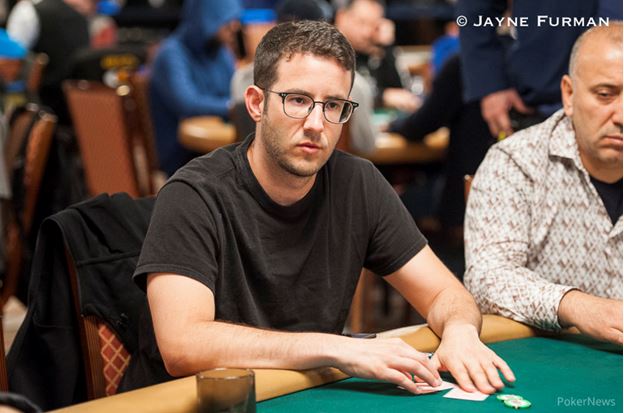

Merson’s total earnings of $9,755,180 at the 2012 WSOP are by far the highest of any POY in the 16-year history of the award. Most of that total came from his win in the Main Event, in which Merson topped a field of 6,598 players and took home the grand prize of $8,531,853.
The Main Event championship was Merson’s second bracelet win of the summer, as just two days before the start of the Main Event Merson took down the $10,000 No Limit Hold’em Six-Handed event for another seven-figure payday, earning $1,136,197 in the process.
Other cash finishes for Merson at the 2012 WSOP included a fifth-place showing in the $2,500 No Limit Hold’em Four-Handed event ($70,280), and 21st place in the $3,000 No Limit Hold’em Six-Handed event ($16,850).
Ed. note: All images are courtesy of wsop.com. For all player photos used, credits are watermarked.
Recently, we’ve seen a great growth of the live casino segment. New technologies have created new opportunities for the operators to take the gambling experience to a whole new level and they’ve readily seized them. These days, you’ll hardly find a large online casino without a live dealer area.


A behind-the-scenes view of what an online casino’s live dealer studio looks like
Just like in brick and mortar venues, these live casinos offer some of the most popular games such as roulette and different variations of card games. And, just like in real casinos, fans of card games are usually split between fans of blackjack and those who prefer different casino-hosted poker variations like Caribbean Stud or Casino Hold’em.
When it comes to choosing your game, you can pretty much find all the different poker and blackjack variations offered across all sorts of stakes. Whether you’re a high roller or a casual player looking for a bit of fun, there are countless UK live dealer blackjack sites like on blackjacksites.info where you can try your luck without breaking the bank. The same applies to poker tables.
So, available stakes aren’t an issue and won’t play a huge role in your decision and neither is the overall quality of the experience. All of these live casinos utilize some top-notch technologies to provide players with smooth, lag-free streams and easy to use interfaces. Thus, looking at the technical side of things, you could go either way.
The fun factor is actually key for most players’ decisions with regards to their choices when it comes to online gambling. While there are some serious punters out there who look to take every edge they can find, most people play for fun and want to have a good time for a few hours.
From that perspective, is blackjack a better choice than one of the casino poker games?
The answer is (surprisingly) that it depends. It is hard to say what’s really fun and what some players find entertaining could be utterly dull and mind-numbing for others. This applies to pretty much all things and online gambling is no exception.
Both blackjack and poker have their good and bad sides if we look at the entertainment value. Blackjack can be very exciting if you get lucky and go on a rush of a few good hands strung together with a couple of nice splits and doubles. Likewise, it can be quite slow-paced at times, with not much happening and your starting bankroll hovering around even for quite a while.
Live poker games have their own appeal. First of all, many of them are the closet thing you can get to playing actual poker without competing against other people. These games use the same hand rankings and many rules found in original game variations like Texas Hold’em and Five Card Stud. Additionally, some of them will offer a jackpot for making different hands, like flushes, full houses, quads, and straight flushes.
If played correctly, blackjack is one of the games with the lowest house edge, which is something to consider if you’re playing seriously and are looking to utilize bonuses to gain an edge over the casino. However, if you’re just playing to have fun, you shouldn’t worry too much about these things.
The thing is, it doesn’t really matter if the game has 1% or 5% house edge if you’re just there for a single session. Things can go your way if you get lucky and this difference doesn’t really come into play over a few dozen or even a few hundred hands.
So, we recommend that you simply play whatever game you enjoy more. If you like blackjack and the fact that you need to know some strategy to actually play well, by all means go for it. If you like the familiarity of poker and the possibility of hitting a big jackpot, that’s perfectly fine as well.
Focus on having fun and try to catch a good run of cards while doing it and you’ll have a blast. But, of course, make sure you know your limits when playing and stick to them as trying to chase your losses is never fun, no matter what game you pick.
Generally speaking, aggression is something that tends to get rewarded in poker. By contrast, betting too aggressively on casino games or on sporting contests and your bankroll could suffer. Aggressors in poker usually perform well and wreak havoc on their opponents. They’re tough to tame!
Celebrity poker pro, author, and coach, Jonathan Little recently wrote a thought-provoking column in Card Player magazine. “How to Combat Good, Loose-Aggressive Players” discusses how to disarm a highly aggressive opponent (a “maniac”) who loves to raise and re-raise. He explains his plan to get “maniac” to play against him in a more straightforward manner. The key concept: “Fight fire with fire.”
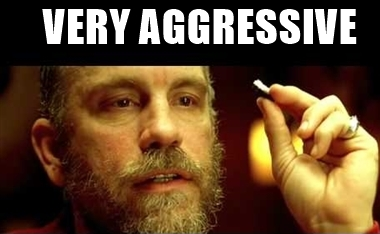

He was playing in the 2018 World Series of Poker Main Event with two such maniacs at his table; and, what’s more, they had position on him. It was a high-stakes, no-limit hold’em game. Early in the event, he put his plan into action. When the maniacs raised and re-raised, Jonathan then re-raised aggressively, making it a 4-bet. One benefit, he cites, of making such a play early is that, if it fails, he won’t lose too many chips.
Result: The two maniacs tended to stay out of his way the rest of the time, making his decisions so much easier. “When you have little fear of being re-raised, you can play a much higher range of hands before the flop with little fear of being outplayed,” he commented. Jonathan noted that had he simply folded to his opponents’ aggression early in the day, as most players would have done, they (the two aggressors) would have almost certainly continued playing aggressively against me for the rest of the day, allowing them to win all the small and medium pots.”
LEARN MORE: Review of Jonathan Little’s Cash Game Master Class
But there is a different perspective worth considering…
The above strategy that Jonathan employed may be fine for high-stakes, and no-limit hold’em contests, but in my opinion is less likely to be effective in low/middle stakes games that most of us recreational players prefer or fixed limit games. In such games, the money involved is not a big enough threat to change the aggressor’s strategy.
In limit hold’em in particular, I prefer to use position against highly aggressive opponents. If possible, try to get seated to his left. Then you can easily fold weaker hands – those that barely meet our hold’em Algorithm criteria – without any cost when they raise. Furthermore, when you do have a strong playing hand (e.g., a decent drawing hand), your raise will help to thin the playing field, giving you a much better chance of winning the pot when you connect – or when you decide to semi-bluff on the turn.
But, what if you are seated to the right of the maniac aggressor? In that case, it would be prudent to muck your hole cards unless they’re strong enough to withstand a raise; e.g., a premium drawing hand, suited connectors, or medium/high pair.
In fact, if you are fortunate to catch a made hand or one with lots of good outs (8 or more), you might make use of an aggressor to pull off a check-raise, expecting to take that pot. Check your hand and let the aggressor do the betting for you. Then, after several other players have called his bet, your raise is bound to swell the pot as they (almost invariably) will call your 2-bet.
In conclusion: If you are in a high-stakes (or no-limit) game, Jonathan Little’s “fight fire with fire” concept is worth considering. In low/middle limit games, I believe my “Taming the Aggressors” strategy is preferable.
P.S. You can always request a seat or table change if the game is too aggressive. It’s up to you!


